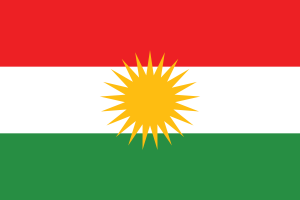Language/Central-kurdish/Grammar/Possessive-Pronouns
| ◀️ Subject Pronouns — Previous Lesson | Next Lesson — Numbers 1-10 ▶️ |
Introduction[edit | edit source]
In this lesson, we will explore the topic of possessive pronouns in Central Kurdish. Possessive pronouns are an essential part of the language as they allow us to express ownership and possession. By understanding how to use them correctly, you will be able to convey relationships between people and objects in Kurdish. This lesson is designed for complete beginners who are starting their journey to learn Central Kurdish. By the end of this lesson, you will have a solid foundation in using possessive pronouns and be able to confidently express ownership in your sentences.
Possessive Pronouns in Central Kurdish[edit | edit source]
Possessive pronouns are used to show that something belongs to someone or something else. In Central Kurdish, possessive pronouns agree with the noun they modify in gender and number. Let's take a look at the different forms of possessive pronouns in Central Kurdish:
| Central Kurdish | Pronunciation | English Translation |
|---|---|---|
| min (من) | min | my |
| te (تە) | te | your (singular) |
| wî (وێ) | ve | his/hers/its |
| me (مە) | me | our |
| we (وە) | we | your (plural) |
| wan (وان) | wan | their |
As you can see, possessive pronouns in Central Kurdish have specific forms for different grammatical categories. It's important to pay attention to these forms to ensure proper agreement with the noun being modified.
Using Possessive Pronouns in Sentences[edit | edit source]
Now that we have learned the different forms of possessive pronouns in Central Kurdish, let's see how they can be used in sentences. Here are a few examples:
1. This is my book. ئەم کتێبەکەم بە. Em kitêbêkê min e.
2. Is this your house? ئەم خانەت بە. Em xanê te ye?
3. His car is very fast. ئەو ئۆتۆمۆبەلەیەکی وێ بە. Ew otomobîlekî wê ye.
4. Our friend is coming tomorrow. دوستی مەکەم سەبەرمان دەکات. Dostê me şêberman dekat.
5. Are these your bags? ئەم چاوپەسانەت بە. Em çawpêsanên te ne?
6. Their house is big. ئەو خانەیانە بەرزەنگە. Ew xanên wan in.
As you can see from these examples, possessive pronouns are placed before the noun they modify. They agree with the gender and number of the noun, ensuring proper agreement in the sentence.
Cultural Insights[edit | edit source]
In Central Kurdish-speaking regions, possession and ownership are highly valued. Expressing ownership through possessive pronouns is a common practice in everyday conversations. Additionally, possessive pronouns can also be used to show affection or closeness to someone or something. For example, using the possessive pronoun "min" (my) can indicate a sense of personal attachment or importance.
Historically, possession was a significant aspect of Kurdish culture due to the nomadic lifestyle of many Kurdish tribes. Possessions were portable and often carried great value. This cultural influence is still reflected in the language today, where possessive pronouns play a prominent role in expressing ownership.
Practice Exercises[edit | edit source]
Now it's time to practice using possessive pronouns in Central Kurdish. Complete the following exercises and check your answers below:
Exercise 1: Fill in the blanks with the correct possessive pronoun. 1. Em xanê ___ e. (our) 2. Ev pirtûk ___ e. (his/hers/its) 3. Em çawpêsanên ___ ne. (you - plural) 4. Dostê ___ şêberman dekat. (me) 5. Ew otomobîlekî ___ ye. (their)
Exercise 2: Translate the following sentences into Central Kurdish. 1. Is this your cat? 2. Her house is beautiful. 3. These books are mine. 4. Our car is old. 5. His family is coming tomorrow.
Exercise 3: Create your own sentences using possessive pronouns in Central Kurdish.
Exercise Solutions[edit | edit source]
Exercise 1: 1. Em xanê me e. 2. Ev pirtûk wî e. 3. Em çawpêsanên we ne. 4. Dostê min şêberman dekat. 5. Ew otomobîlekî wan ye.
Exercise 2: 1. ئەم گەورەیەتەکەت بە؟ 2. خانەی وێ بەرزەنگەیە. 3. ئەم کتێبانە پەیمانە. 4. خانەی مە بەرزەنگەیە. 5. خێزانێکی وێ سەبەرمان دەکات.
Exercise 3: (Answers may vary) 1. ئەم مۆبایلەکەم بە. 2. ئەو گەورەیەیە تۆی بە. 3. دوستەکەمان لەناو خانەیاندا بە. 4. دەستەکەمان لەسەر بیرکاریەکەت بە. 5. ئەو کچەکە دەرمانی خێزانی خۆیە بە.
Conclusion[edit | edit source]
Congratulations! You have successfully learned how to use possessive pronouns in Central Kurdish. Possessive pronouns are an important part of the language and allow us to express ownership and possession. By practicing the exercises and examples in this lesson, you have gained a solid understanding of how to use possessive pronouns correctly. Keep practicing and incorporating possessive pronouns into your conversations to further improve your Central Kurdish language skills.
Other Lessons[edit | edit source]
- Nouns
- Future Tense
- Present Tense
- Subject Pronouns
- Negation
- Comparative and Superlative
- Common Conjunctions
- Adjectives
- Plurals
- Past Tense
Template:Central-kurdish-Page-Bottom
| ◀️ Subject Pronouns — Previous Lesson | Next Lesson — Numbers 1-10 ▶️ |

